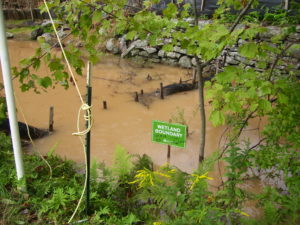Forty-seven years ago, on April 22, 1970, communities around the nation marched to defend the earth. They brought banners, signs, chants, and a realization that environmental degradation damages every aspect of our lives and our communities. When we pollute the water, the air, and the land, people suffer – our health is impacted, recreational opportunities wane, our economy is damaged, and overall our quality of life is diminished.
 As a result of the activism leading up to and out of the 1970s, we saw a wave of environmental protection laws, regulations policies, programs passed – the Clean Water Act, the Clean Air Act, the Coastal Zone Management Act and more. But have we really secured the high-level environmental protection we were seeking?
As a result of the activism leading up to and out of the 1970s, we saw a wave of environmental protection laws, regulations policies, programs passed – the Clean Water Act, the Clean Air Act, the Coastal Zone Management Act and more. But have we really secured the high-level environmental protection we were seeking?
While environmental protection laws have brought many benefits, they have not brought us the protection from environmental degradation we were seeking or we need today. For the most part, environmental protection laws do not make it illegal to pollute, they just require government permission to do so. For example, the Clean Water Act, since its inception, legalizes water pollution to the extent a company secures a permit.
Furthermore, there are many pollutants and sources of pollution that remain unregulated. As part of an investigation into drinking water pollution, the Environmental Working Group found:
A look at the newspapers demonstrates that despite the passage of environmental protection laws, the health of our environment and therefore our communities is far from secure.
- Hoosick Falls Residents shocked by High PFOA Test Results.
- How Tap Water Became Toxic in Flint Michigan.
- DEP Urged to Act Quickly on Hazardous Chemical Found In NJ Water Supplies
- Study: Fracking Industry Wells Associated with Premature Birth, Johns Hopkins Bloomberg School of Public Health
- A disaster waiting to happen in Oklahoma? The link between fracking and earthquakes is causing alarm in an oil-rich town
 And in this age of Trump, with the massive attacks on environmental protection taken by the President and his administration, we can see that when we have political leaders who don’t value the protection and restoration of our environment, our laws leave plenty of opportunity for advancing environmental assaults, pollution, and degradation.
And in this age of Trump, with the massive attacks on environmental protection taken by the President and his administration, we can see that when we have political leaders who don’t value the protection and restoration of our environment, our laws leave plenty of opportunity for advancing environmental assaults, pollution, and degradation.
Given all the laws that have been passed, how is it that our environment—that which sustains every aspect of our lives and is essential for our healthy lives—is not better protected?
As explored in the new book, The Green Amendment, Securing Our Rights to a Healthy Environment, the fact is that our right to bear arms, our right to free speech, our right to freedom of religion, our property rights, are among the many aspects of our lives that are better protected under the law than our right to healthy water to drink and healthy air to breathe. That is because these fundamental political rights are protected as inalienable rights in our federal constitution and many state constitutions while our right to clean water, clean air, healthy soils, and a healthy environment are not.
Right now there are only two states with strong constitutional provisions protecting environmental rights as a fundamental, inherent, and/or indefeasible right: Pennsylvania and Montana.
 We’ve seen the power that political organizing can have to advance the cause of environmental protection and to bring critically needed change. We have come a long way since 1970 but we have much more to do to protect our environment and secure our collective future. Its time to pass Green Amendments for every state constitution across our nation, and once we have that effort solidly underway we will be well poised to fight for, and pass, a federal constitutional right to a healthy environment.
We’ve seen the power that political organizing can have to advance the cause of environmental protection and to bring critically needed change. We have come a long way since 1970 but we have much more to do to protect our environment and secure our collective future. Its time to pass Green Amendments for every state constitution across our nation, and once we have that effort solidly underway we will be well poised to fight for, and pass, a federal constitutional right to a healthy environment.



